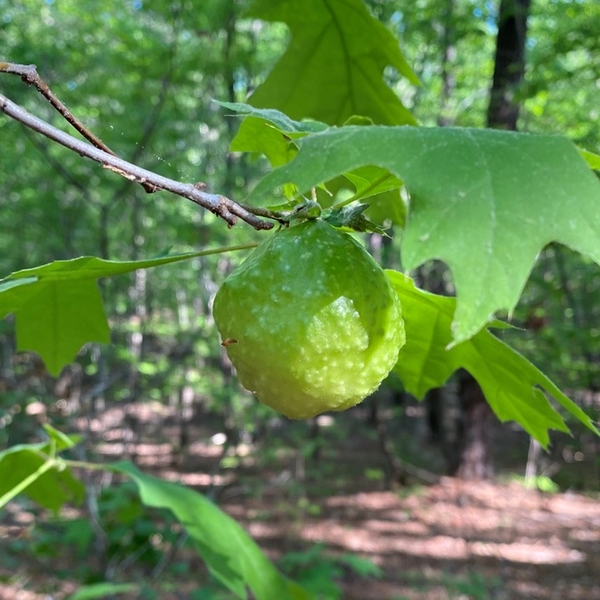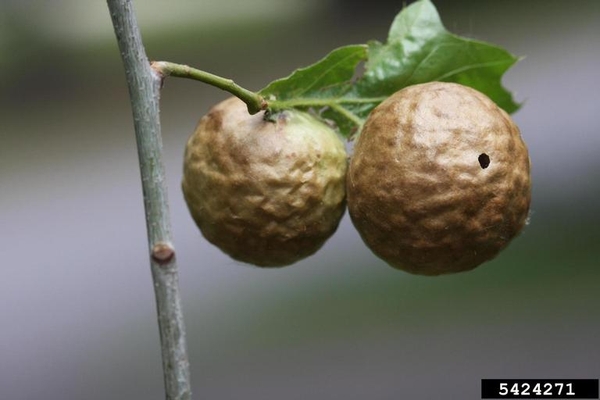Introduction
Oak apple galls are conspicuous, abnormal growths that occur on the leaves of oak trees (Quercus spp.). As their name suggests, these spherical, green galls resemble apples. The galls are induced by several species of wasps that utilize nutrients from the growth for larval development. As is the case with most plant galls, oak apple galls do not typically harm the oak tree, so management is often unwarranted.

Oak apple galls are named for their resemblance to apples. While the growths may appear alarming, they are usually harmless to the health of the host tree.
Courtney Johnson, NC State University CC BY 4.0
Host Plants
Oak apple galls occur on oak trees (Quercus spp.). Most commonly, the growths are found on scarlet, red, and black oaks.
Identification
These galls are named for their round shape and green color, which resemble apples. Usually, the growths are about two inches in diameter. Oak apple galls often have bumps that are purplish in color. When the wasps housed within the galls finish their development and exit, the galls turn brown. Some galls have white, spongy tissue on the inside whereas others have white fibers extending from the chambers where larvae develop.
Gall-Inducers
Several wasp species in the family Cynipidae (gall wasps) are responsible for the formation of oak apple galls. Most species that create oak apple galls occur in the genus Amphibolips.
Oak apple galls are produced to support developing wasps. A female wasp deposits an egg within the tissues of an oak leaf, and secretions from the resulting immature wasp (larva) lead to gall formation. A single wasp develops within each oak apple gall in a chamber. As the wasp grows, it feeds on special cells called nutritive cells that grow within the gall. Nutritive tissue that is fed upon by the wasp is replaced by neighboring cells, so these wasps have a steady supply of food.
Not only do galls provide nutrients for developing wasps, but they also provide safety. As they are enclosed by the galls, these wasps are sheltered from natural enemies. Factors like toughness of galls, thickness of gall walls, and the number of larval chambers within galls may impact how effective the gall is at protecting immature wasps (Stone et al., 2002). One study found that a species of oak apple gall wasp in California more often survived to adulthood in larger galls and in galls that developed late in the summer (Joseph et al., 2011). Acidity and tannin content of galls can also serve as a defense tactic. For example, in one study oak apple galls contained more tannins whereas the closely-related translucent oak galls had a much higher acidity, demonstrating two possible defense tactics. Similar to cells in fruits, the translucent oak galls in the study contained cells to store acid (Guiguet et al., 2023).
In short, oak apple galls serve as food and defense for developing wasps, and they typically do not harm the host trees.
Life Cycle
The life cycle of oak gall wasps is relatively complex and atypical in comparison to other insects. Gall wasps in the family Cynipidae engage in a reproductive strategy called cyclical parthenogenesis, which only occurs in a few animal groups (Stone et al., 2002). Cyclical parthenogenesis means there are alternating generations that reproduce sexually and asexually. Some generations of oak gall wasps reproduce through clones, whereas other generations require a male and female to mate. Many species are bivoltine, meaning two generations occur each year. However, the lifecycles of gall wasps vary greatly based on the species and environment (Stone et al., 2002). Although they are called “wasps”, gall wasps cannot sting.
Management
Management is usually unwarranted for oak apple galls. Some wasp species in the family Cynipidae may cause injury or death on small branches from the galls they produce, but most species do not cause damage. In fact, galls produced by some cynipids have been considered economically valuable. Historically, some oak galls were used for manufacturing ink or occasionally for feeding livestock (USDA Forest Service, 1985). Natural enemies often reduce the numbers of oak apple galls.
Natural Enemies and Ecology
Several natural enemies attack oak apple gall wasps. For example, some parasitoid wasps use oak gall wasps as hosts for their own larvae. These parasitoid wasps deposit their eggs either within the galls or within the developing oak gall wasp larvae; the resulting parasitoid wasp larvae consume the oak gall wasp larvae (Stone et al., 2002). Other insect species, termed inquilines, “take over” the gall and use it for their own development. Some inquilines kill the developing oak gall larvae, but others do not harm them. These inquilines are often wasps or moths. Additionally, animals like rodents and woodpeckers may consume developing oak gall larvae, and herbivorous insects may feed on leaf tissue and kill the larvae (Stone et al., 2002).
In addition to natural enemies, oak apple galls may provide habitat for other species. For example, spiders or beetles may use the galls for habitat in the winter. In one study occurring in California, researchers found that galls were dominated by jumping spiders, and they suggest that these spiders influenced the arthropod communities on host trees by reducing the number of herbivorous species (Wetzel et al., 2016). Due to the indirect impact on these communities, the authors refer to oak gall wasps as ecosystem engineers.
References
Boggs, J. (2016, June 13). Oak apple wasp galls. Buckeye Yard & Garden Online.
Boggs, J. (2023, May 12). Oak apples, woolly catkins, and leaf blisters. Buckeye Yard & Garden Online.
Guiguet, A., McCartney, N. B., Gilbert, K. J., Tooker, J. F., Deans, A. R., Ali, J. G., & Hines, H. M. (2023). Extreme acidity in a cynipid gall: A potential new defensive strategy against natural enemies. Biology Letters, 19(3).
Hansen, K. (2008, April 16). Oak apple gall - a curiosity. East Texas Gardening.
Joseph, M. B., Gentles, M., & Pearse, I. S. (2010). The parasitoid community of Andricus quercuscalifornicus and its association with gall size, phenology, and location. Biodiversity and Conservation, 20, 203–216.
Stone, G. N., Schönrogge, K., Atkinson, R. J., Bellido, D., & Pujade-Villar, J. (2002). The population biology of oak gall wasps (Hymenoptera: Cynipidae). Annual Review of Entomology, 47, 633–668.
USDA Forest Service. (1985). Family Cynipidae. In Insects of Eastern Forests (pp. 422-425). USDA Forest Service Miscellaneous Publication No. 1426.
Wetzel, W. C., Screen, R. M., Li, I., McKenzie, J., Phillips, K. A., Cruz, M., Zhang, W., Greene, A., Lee, E., Singh, N., Tran, C., & Yang, L. H. (2016). Ecosystem engineering by a gall‐forming wasp indirectly suppresses diversity and density of herbivores on oak trees. Ecology, 97(2), 427–438.
Publication date: Feb. 13, 2025
N.C. Cooperative Extension prohibits discrimination and harassment regardless of age, color, disability, family and marital status, gender identity, national origin, political beliefs, race, religion, sex (including pregnancy), sexual orientation and veteran status.

